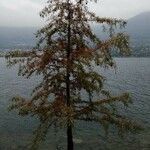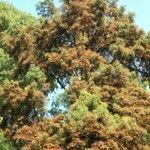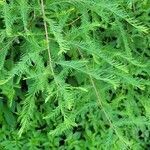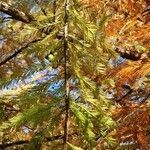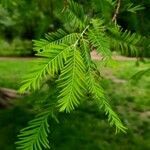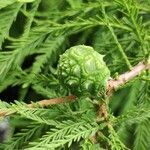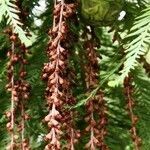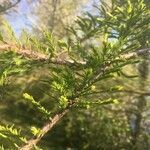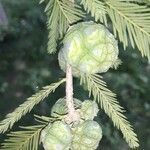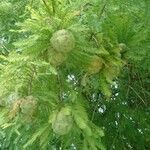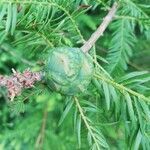Tree to 40 m, the trunk concavely thickened below and conspicuously buttressed at least in mature trees; bark reddish to light brown, with shallow furrows, becoming flaky; leafy branchlets mostly spreading horizontally; lvs narrowly linear, 5–15 mm, divergent, appearing 2-ranked on the branchlets, the free portion of the lf basally contracted and twisted; panicles ca 1 dm, initiated in the autumn, developing in the spring; cones pendulous at the ends of the twigs, 2–3 cm thick, with dull, rugose scales; 2n=22. Brownwater riverine and lacustrine margins and swamps, occasionally in brackish water, chiefly on the coastal plain; Del. (and locally and perhaps only recently n. to L.I.) to Fla. and Tex., n. in the Mississippi Valley to s. Ind. We have only the widespread var. distichum, as here described. Var. imbricarium (Nutt.) Croom (T. ascendens), the pond-cypress, extends n. only to N.C.
Trees seasonally cladoptosic; trunk enlarged basally and often conspicuously buttressed; crown monopodial and conic when young, often becoming irregularly flattopped or deliquescent (branched and so divided that the main axis cannot be determined) with age. Shoot system conspicuously dimorphic, long shoots indeterminate, bearing individually abscising, linear to lanceolate leaves, short shoots determinate, abscising in autumn with their leaves, variable, intergrading, at one extreme pendent to horizontally spreading, bearing decurrent, narrowly linear and laterally divergent leaves in 2 rows, at other extreme strictly ascending to occasionally pendent, bearing short-lanceolate to deltate and tightly appressed leaves. Pollen cones in pendent panicles to ca. 25 cm, 2--3 mm, conspicuous in winter prior to pollination. Seed cones 1.5--4 cm.

